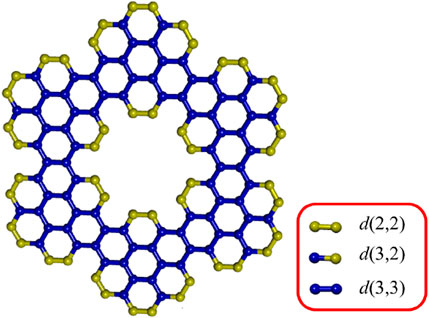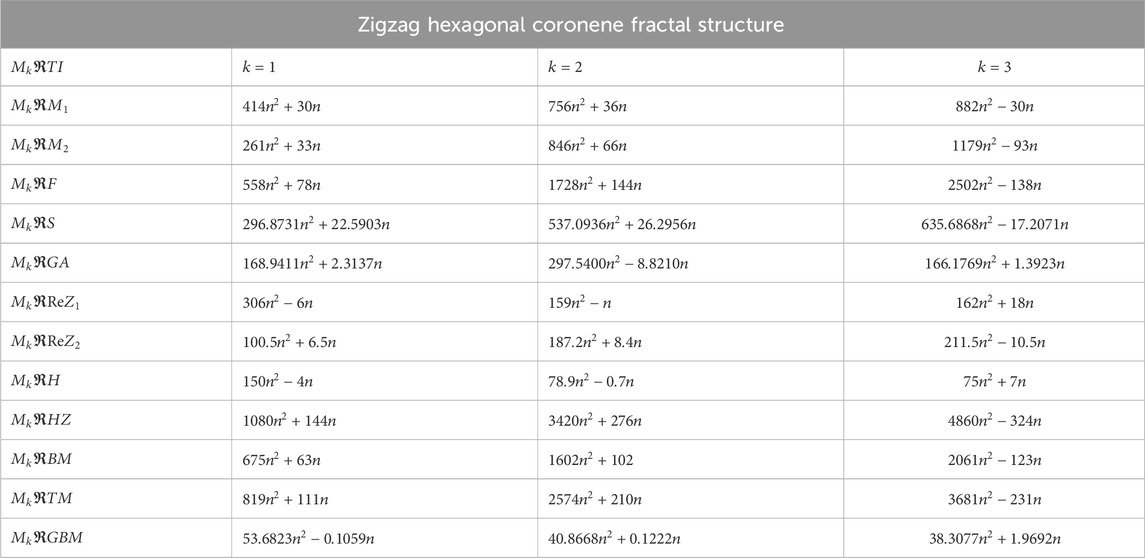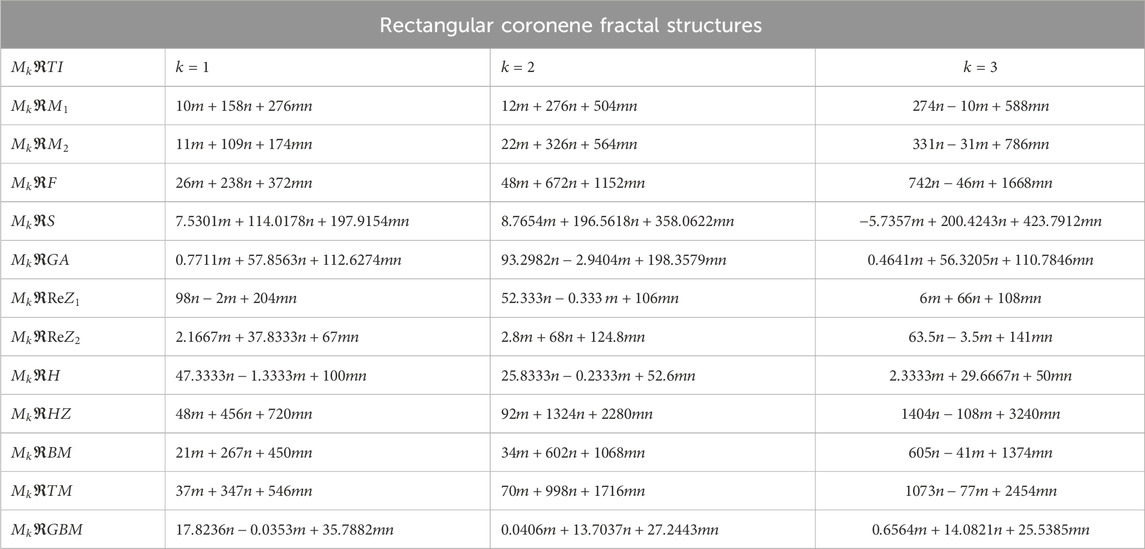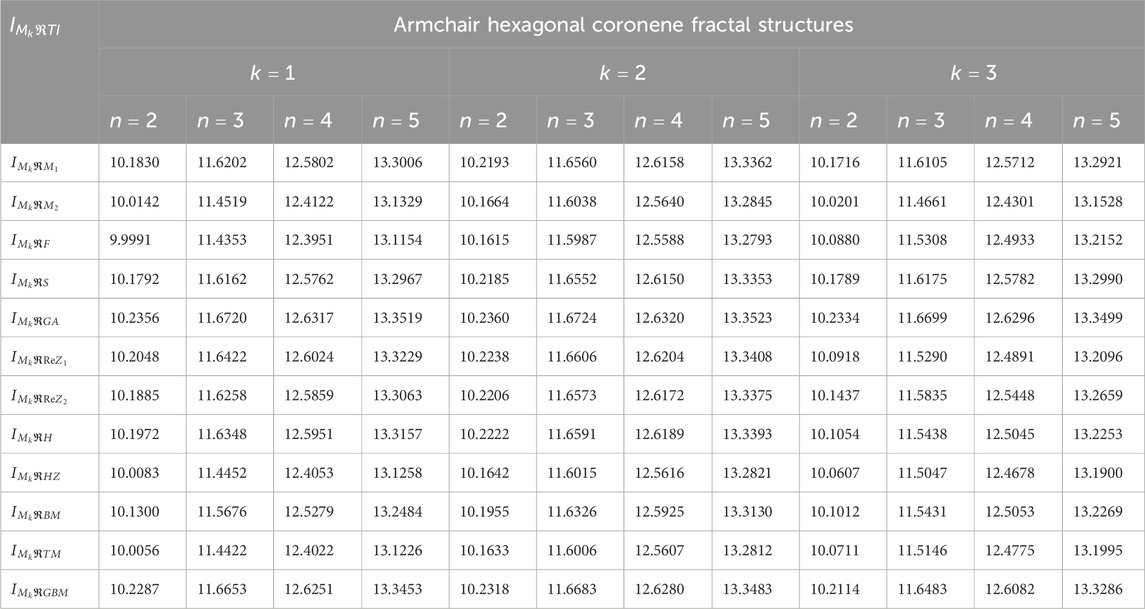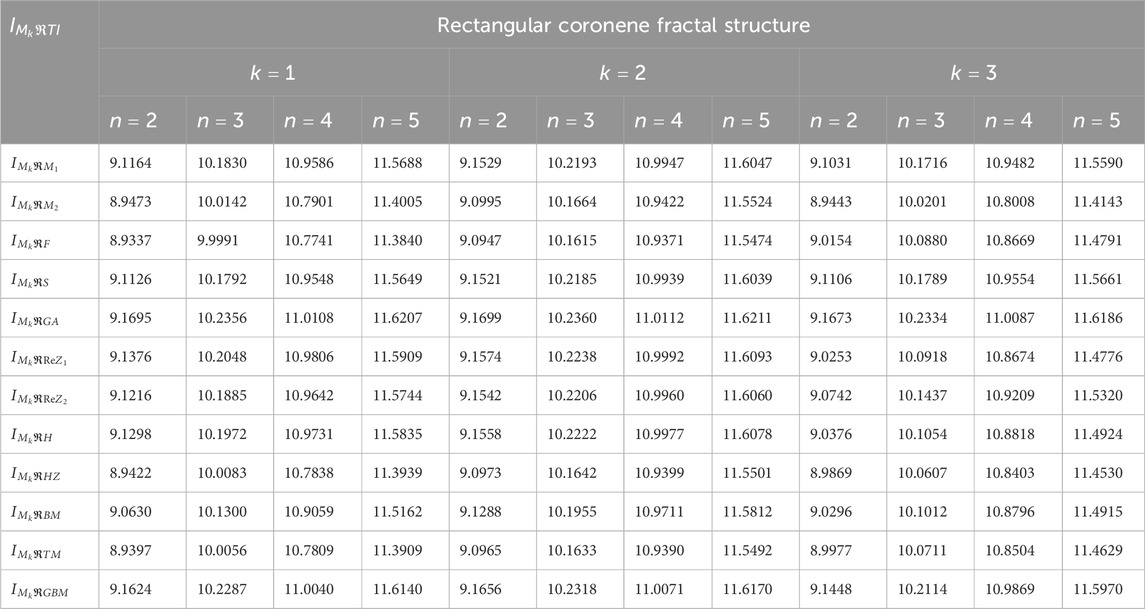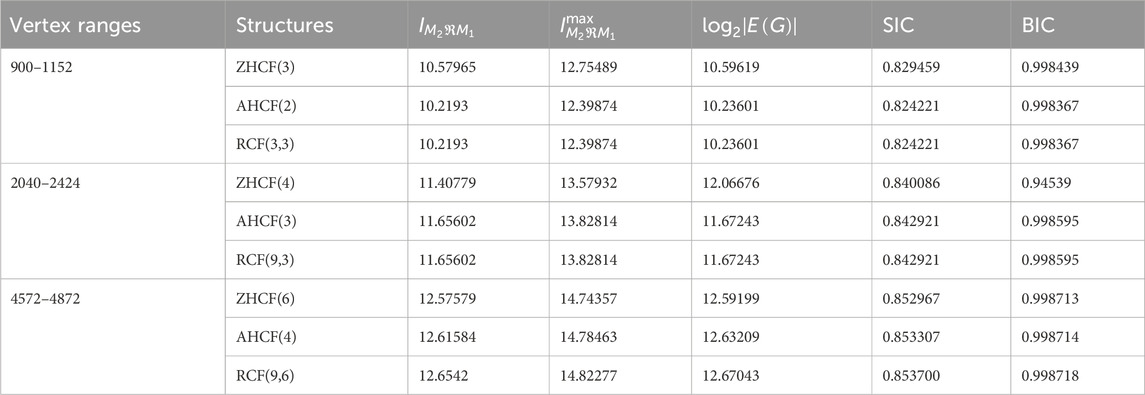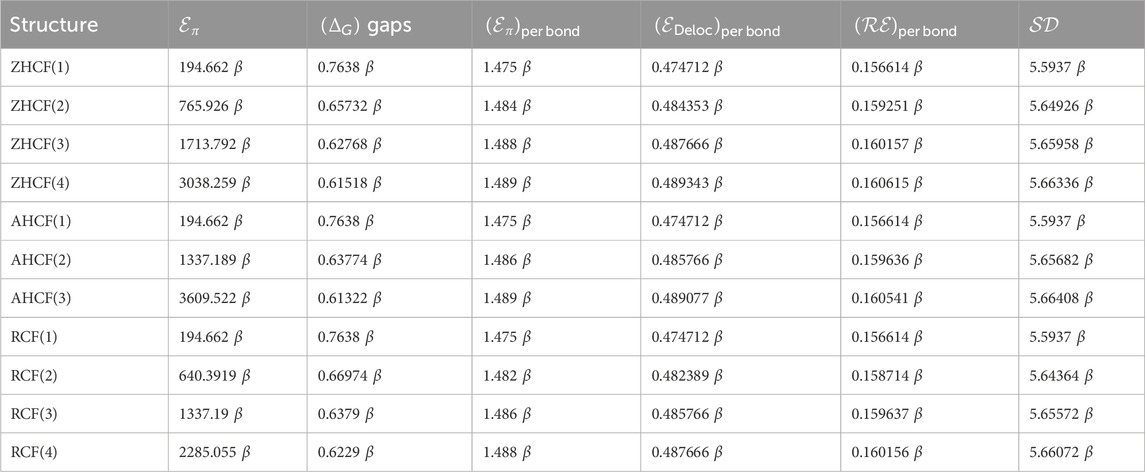- School of Advanced Sciences, Vellore Institute of Technology, Chennai, India
Topological characterization through graph-theoretical methods translates chemical and structural data into quantitative values that represent the molecular system. Our research explores the use of topological indices to study fractal structures. Molecular fractals are complex geometric configurations that exhibit self-similarity at different levels and systematically formed by repeating a fundamental unit. This study focuses on coronene-based molecular fractals, where coronene, a benzenoid molecule with a symmetrical graphite-like structure, finds applications in organic semiconductors, sensors, and molecular electronics, due to its unique electronic and optical properties. Additionally, information entropy is employed to evaluate and compare the structural complexities of coronene fractals. Spectra-based energetic properties such as total
1 Introduction
Benzenoid hydrocarbons are a group of polycyclic compounds consisting of six-member linked rings, characterized by their aroma and unique physicochemical properties. These substances create powerful inter-molecular bonds by acting in single and double bonds alternatively (Hill et al., 2004). Higher-order structural co-ordination is indicated by larger
Fractal geometry, which explores recurring patterns at different scales, has evolved from describing physical theories to serve various applications such as complexes in medical and molecular engineering, neural networks, and laptop graphics, etc (Kirkby, 1983). Extensive research has been carried out using fractal methods. These deterministic fractals arise by combining benzene with hierarchical structure sequences, making them a significant tool for advancing nanotechnology and biotechnology (Uahabi and Atounti, 2015). Clar aromatic sextet theory is a concept introduced by Erich Clar to describe the electronic structure of polycyclic aromatic hydrocarbons (PAHs). It is particularly useful for understanding resonance, stability, and reactivity in PAH systems (Hosoya, 2005). Fractal molecular architecture, often analyzed through Clar’s system and golden ratio measurements, exhibits scaling properties that demonstrate its adaptability and potential (Lee and Chang, 1996). Studies of coronene-based fractals have shown that they can serve as supports for advanced nanomaterials (Nisha and Senthil Kumar, 2020). Despite significant advances in theoretical research, the integration of these complex systems remains a challenge, requiring further research (Kumar et al., 2017). Recent work emphasis on the unique aromatic properties and scaling behavior of fractal benzenoids, emphasizes their importance in development and fabrication of high-performance nanomaterials for optical and electronic device applications (Duan et al., 2021).
In computational chemistry, topological indices considered as are important tools that provide information on the chemical and structural characteristics of molecules (Estrada and Uriarte, 2001; Kumar and Das, 2024). Among these, the degree-based Zagreb index and the distance-based Wiener index have been crucial in forecasting molecular characteristics, including stability and boiling points (Wiener, 1947; Gutman and Trinajstić, 1972). In this article, we utilize modified reverse degree-based indices that incorporate a variable parameter, “
Entropy analysis is a fundamental method in the field of information theory, which offers special insights into the complexity and stability of molecules. Shannon’s entropy measures structural randomness (Dehmer, 2008; Shannon, 1948), while graph entropy is related to the vertices and edges of molecular graphs, which makes it easier to analyze a system using graph structures. Higher entropy of a structure constitutes more disorderness in the macrostructure, which reduces structural stability. However, high entropy materials, such as high-entropy alloys (HEAs), exhibit unique properties due to their high configurational entropy, which can result in the formation of stable disordered solid solutions. While high entropy promotes disorderness, it can also contribute to distinctive structural stabilities and desirable properties. For instance, HEAs are known for their high strength, ductility, and resistance to wear and corrosion.
Research articles focused on molecular fractals have explored various structural and topological aspects (Malik et al., 2023; Xu and Liu, 2025; Yogalakshmi and Easwaramoorthy, 2024). Recent studies on coronene fractals have examined degree and degree-sum properties, reverse degree-based indices, and coronene frameworks, as discussed in (Arockiaraj et al., 2022; Ullah et al., 2024; Khabyah et al., 2023). This study explores coronene fractal structures, analyzing their entropy levels and complexity through modified reverse degree-based indices. By delving into their structural and spectral features, it aims to deepen our understanding of their stability, complexity, and overall properties.
2 Methodology
In this study, we examine three configurations of coronene fractals modeled as two-dimensional molecular graph structure and is represented by
Modified reverse degree-based topological indices,
where
where
The total
The topological index functions based on the modified reverse degree are outlined below.
• Modified reverse first Zagreb index
• Modified reverse second Zagreb index
• Modified reverse forgotten index
• Modified reverse Sombor index
• Modified reverse geometric arithmetic index
• Modified reverse hyper-Zagreb index
• Modified reverse harmonic index
• Modified reverse first redefined Zagreb index
• Modified reverse second redefined Zagreb index
• Modified reverse bi-Zagreb index
• Modified reverse tri-Zagreb index
• Modified reverse geometric bi-Zagreb index
3 Evaluation of modified reverse degree indices
We explore three coronene fractal configurations: ZHCF
To calculate the modified reverse topological indices, edge partitioning is used, as illustrated in Figure 1, for three configurations of coronene fractals based on their standard vertex degrees, as detailed in Table 1. Each index involves complex computations with varying parameters. For instance, the calculation of the first Zagreb-based index is demonstrated using ZHCF coronene structures for different values of
For
Similarly for
The modified reverse degree-based indices illustrated in Equations 1–12, combined with the edge partitioning present in Table 1, are employed to compute the
4 Evaluation of graph entropy
A mathematical foundation for assessing a system’s randomness and uncertainty is provided by Shannon’s concept of entropy, which quantifies the content of possibility distributions. For a discrete random variable
where
Based on this foundation, incorporating topological indices into the entropy framework appears as a robust approach to assess molecular complexity. This approach focuses on graph edges and uses topological indices
Further the graph entropy equation simplifies as:
By employing specific topological indices, the simplified representation makes it easier to calculate graph entropy for a molecular graphs of coronene fractals. For example, the modified first Zagreb index applied to a ZHCF
Employing degree-based edge partitions presented in Table 1, the entropy of ZHCF
The entropy expressions for all configuration of coronene fractals are too extensive to display. Therefore, Tables 5–7 present the comparison of numerical values of modified reverse degree-based entropy levels for the fractal structures. For rectangular coronene fractals, we assume
The entropy stages provided in Tables 5–7 monitor dynamic variation throughout the three configurations of coronene fractals for
4.1 Relative complexity metrics
This subsection offers numerical and graphical estimation of complexity across the configurations of coronene fractals, emphasizing the importance of accounting for molecular size differences. Since graph entropy values are depending on the size of the molecular graph, the application of relative complexity measures has become essential for higher comparisons among molecular systems of varying dimensions (Dehmer, 2008). To address this, two normalized measures, namely structural information content (SIC) and bond information content (BIC), are introduced. Graph entropy alone may not adequately reflect structural complexity, especially for systems with differing dimensional sizes, highlighting the necessity of employing relative metrics (Bonchev and Trinajstić, 1982; Sabirov and Shepelevich, 2021). The maximum entropy concept is used to establish these metrics, where the limiting entropy value for
Similarly, BIC includes a molecular graph where edges are counted to compute relative complexity. The formula for the BIC normalizes the entropy using the logarithmic scale of the total number of edges, as shown here:
From Equations 13, 14, we calculate the SIC and BIC measures for coronene fractals. The analysis focuses on the entropy values of the Zagreb index when
The SIC and BIC measures for other coronene fractals across various vertex ranges, are presented in Table 8. These relative complexity measures offer a comparative analysis of complexity across different sizes, with values ranging from 0 to 1, where 1 indicates the highest complexity and 0 the lowest. The SIC and BIC measures, are shown in Table 8, with a graphical comparison in Figure 3.
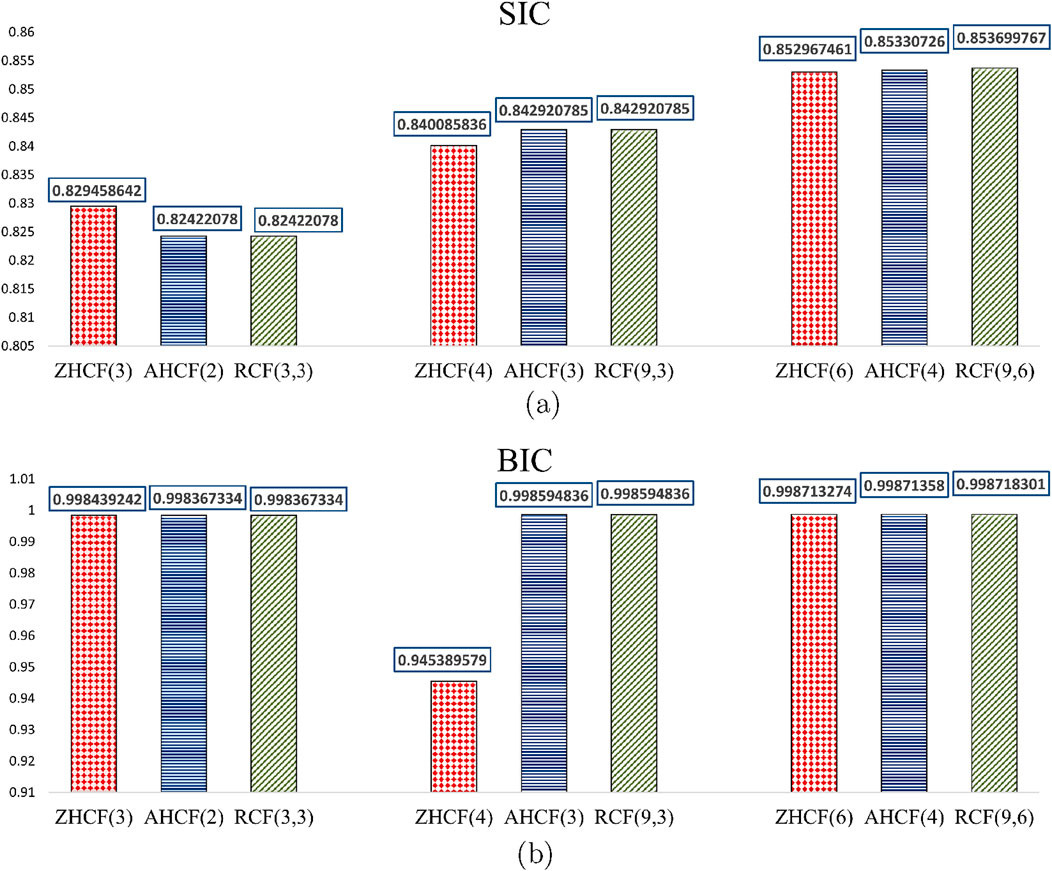
Figure 3. Graphical comparison of complexity measures among zigzag, armchair and rectangular coronene fractals. (a) Comparison of SIC measures across the range of k values for coronene fractals. (b) Comparison of BIC measures across the range of k values for coronene fractals.
Table 8; Figure 3 show that RCF and AHCF exhibit similar complexity values at small scales. However, with increasing size, the rectangular fractals exhibits slightly higher complexity compared to armchair configuration, while the zigzag-based coronene exhibits lower complexity than all other configurations because BIC is evaluated based on number of bonds in molecular graph and SIC obtained from maximum entropy. These two analyzes facilitate better comparisons, and help to determine the most appropriate indicator of complexity measures for molecular system.
From Figure 3; Tables 5–8, greater entropy variations are observed among the three configurations for smaller structures, while for the largest structure, all configurations approach the 2D graphitic sheet, and their entropy values converge to a limit. However, two types of isentropic structures exist: AHCF(2) and RCF(3,3) have the same number of vertices (900) and edges (1206); similarly, AHCF(3) and RCF(9,3) share the same number of vertices (2424) and edges (3264). Thus, we use spectral properties for a more conclusive analysis of stability.
5 Analysis of spectral properties in coronene fractals
This section focuses on the spectral properties of coronene fractals, using metrics derived from their graph spectra. Since these structures are two-dimensional and satisfy the Coulson-Rushbrook theorem, this method is more effective for analysis. It is not practical to perform complete
The total
The
The HOMO-LUMO energy gaps, defined as the difference between the highest molecular orbital (HOMO) denoted
Thermodynamic stability is closely related to parameters such as delocalization and resonance energies, which generally increase with molecule size, increasing the stability. The delocalization energy
The data present in Table 9; Figure 4 show that the HOMO-LUMO energy gaps decrease as the size of coronene structures increase. This suggests that larger structures have more electronic delocalization and resonance energy, which results in lower energy differences between the highest occupied molecular orbital (HOMO) and the lowest unoccupied molecular orbital (LUMO). Meanwhile, both delocalization and resonance energy show an increasing trend, reflecting enhanced stability and conjugation within these structures. Among the fractal configurations analyzed, the rectangular coronene fractals have the largest HOMO-LUMO energy gaps, suggesting high kinetic stability, lower reactivity, and the lowest delocalization and resonance energies. On the other hand, armchair coronene fractals display the smallest HOMO-LUMO energy gaps, indicating less kinetic stability, larger chemical reactivity, higher electron delocalization, and resonance energies, all of which lead to greater stability with efficient electron transfer. This study emphasizes the significance of structural configuration on stability and reactivity in coronene fractals.
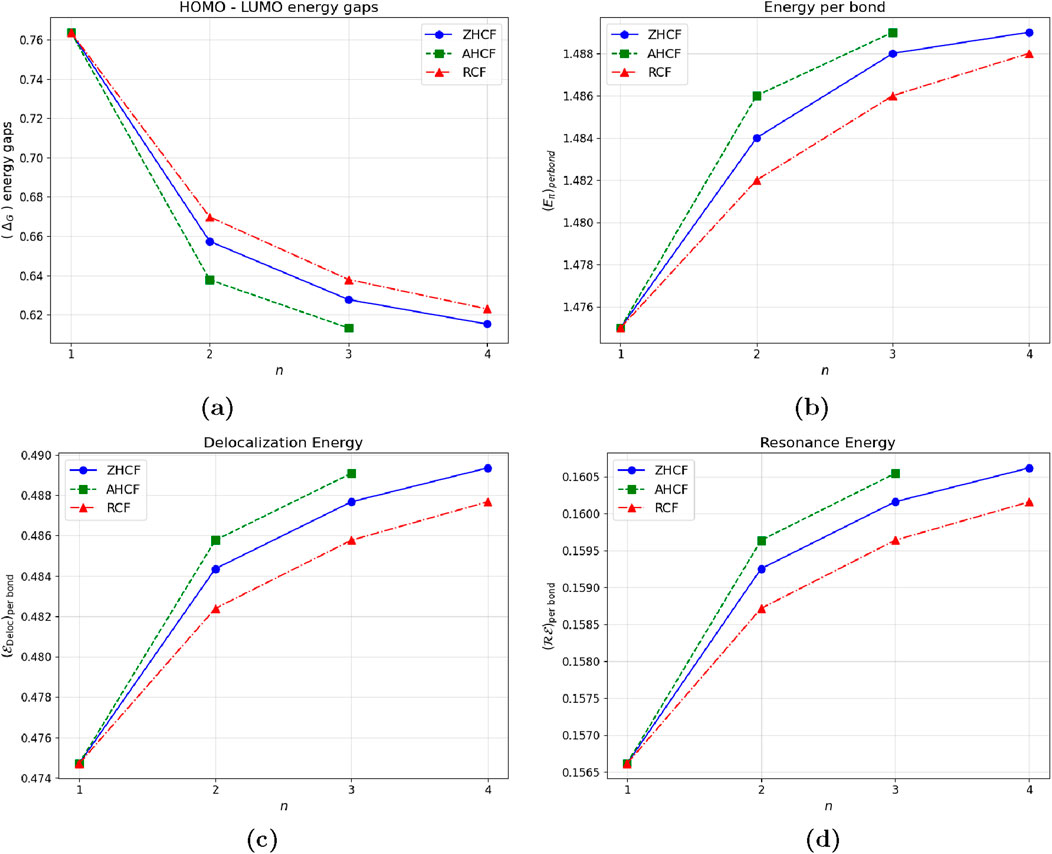
Figure 4. Graphical representation of energetic properties across kekulene tessellations. (a) HOMO-LUMO energy gap (b) Energy per bond (c) Delocalization energy per bond (d) Resonance energy per bond.
6 Predictive models
The prediction of the spectral properties of chemical structure by graph-entropy measures utilizes structure-property models which play an important role in characterizing and prediction chemical properties using topological indices (Raza et al., 2024; Rauf et al., 2022) These models offer a cost-effective alternative to experimental studies, offering reliability, accuracy and robustness (Hayat et al., 2019). For coronene fractals, we examine the relationship between spectral features and entropy measurements obtained from the reverse degree-based indices. Our findings show that there is a better correlation between the entropy measures and spectral properties, except for the HOMO-LUMO energy gap, which exhibits negative correlation due to its decrease in energy gaps with increasing system size. As noted in the previous section, the first Zagreb index was employed to compare relative complexity measures among the structures. We found that entropy measures associated with
The regression models optimized to predict spectral characteristics are given detailed in Table 10 and illustrated in Figure 5. The selection was based on their unique performance indicators, such as
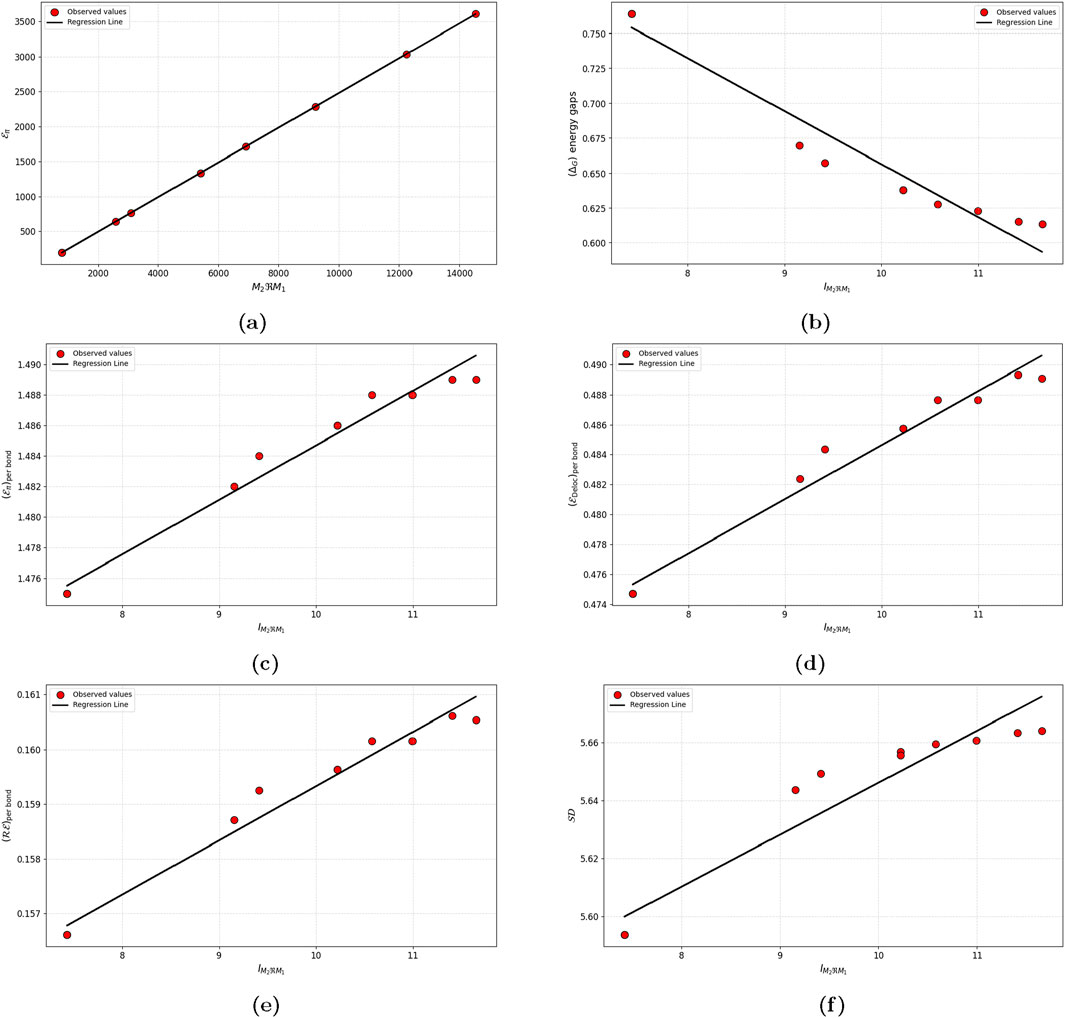
Figure 5. Linear regression models for the energetic properties. (a) Total π electron energy (b) Homo-Lumo energy gap (c) Energy per bond (d) Delocalization energy (e) Resonance energy per bond (f) Spectral diameter.
7 Conclusion
In this paper, we develop topological expressions based on modified reverse degree-based indices for three configurations of two-dimensional coronene fractals. These indices capture structural complexities and are effective in predicting physico-chemical properties. The computed indices function as graph-based metrics for evaluating entropy levels and relative complexity. The resulting entropy values offer insights into the structural challenges of these fractal systems, providing a foundation for further investigation into their properties. When paired with graph spectra, these approaches form a comprehensive machine learning framework for efficiently and accurately computing the spectral and thermodynamic properties of fractals and other two-dimensional materials. By integrating graph-theoretic methods with advanced statistical techniques, this study contributes to the development of improved computational chemistry algorithms, particularly for QSAR and QSPR studies aimed at predicting the stability and characteristics of complex chemical systems.
Data availability statement
The original contributions presented in the study are included in the article/supplementary material, further inquiries can be directed to the corresponding author.
Author contributions
AK: Conceptualization, Formal Analysis, Methodology, Writing – original draft. AG: Investigation, Methodology, Supervision, Validation, Writing – review and editing.
Funding
The author(s) declare that no financial support was received for the research and/or publication of this article.
Conflict of interest
The authors declare that the research was conducted in the absence of any commercial or financial relationships that could be construed as a potential conflict of interest.
Generative AI statement
The author(s) declare that no Generative AI was used in the creation of this manuscript.
Publisher’s note
All claims expressed in this article are solely those of the authors and do not necessarily represent those of their affiliated organizations, or those of the publisher, the editors and the reviewers. Any product that may be evaluated in this article, or claim that may be made by its manufacturer, is not guaranteed or endorsed by the publisher.
References
Abul Kalaam, A. R., and Berin Greeni, A. (2024). Comparative analysis of modified reverse degree topological indices for certain carbon nanosheets using entropy measures and multi criteria decision-making analysis, Int. J. Quantum Chem. 124(1), pe.27326, doi:10.1002/qua.27326
Arockiaraj, M., Greeni, A. B., and Kalaam, A. A. (2023a). Linear versus cubic regression models for analyzing generalized reverse degree based topological indices of certain latest corona treatment drug molecules, Int. J. Quantum. Chem. 123(10), pe.27136, doi:10.1002/qua.27136
Arockiaraj, M., Greeni, A. B., and Kalaam, A. A. (2023b). Comparative analysis of reverse degree and entropy topological indices for drug molecules in blood cancer treatment through QSPR regression models. Polycycl. Aromat. Compd., 1–18. doi:10.1080/10406638.2023.2271648
Arockiaraj, M., Greeni, A. B., Kalaam, A. A., Aziz, T., and Alharbi, M. (2024). Mathematical modeling for prediction of physicochemical characteristics of cardiovascular drugs via modified reverse degree topological indices. EPJE 47 (8), 53. doi:10.1140/epje/s10189-024-00446-3
Arockiaraj, M., Jency, J., Abraham, J., Ruth Julie Kavitha, S., and Balasubramanian, K. (2022). Two-dimensional coronene fractal structures: topological entropy measures, energetics, NMR and ESR spectroscopic patterns and existence of isentropic structures. Mol. Phys. 120 (11), e2079568. doi:10.1080/00268976.2022.2079568
Arockiaraj, M., Jency, J., Mushtaq, S., Shalini, A. J., and Balasubramanian, K. (2023d). Covalent organic frameworks: topological characterizations, spectral patterns and graph entropies. J. Math. Chem. 61, 1633–1664. doi:10.1007/s10910-023-01477-5
Arockiaraj, M., Paul, D., Clement, J., Tigga, S., Jacob, K., and Balasubramanian, K. (2023c). Novel molecular hybrid geometric-harmonic-Zagreb degree based descriptors and their efficacy in QSPR studies of polycyclic aromatic hydrocarbons. SAR QSAR Environ. Res. 34, 569–589. doi:10.1080/1062936x.2023.2239149
Balasubramanian, K. (2023). Topological indices, graph spectra, entropies, Laplacians, and matching polynomials of n-dimensional hypercubes. Symmetry 15 (2), 557. doi:10.3390/sym15020557
Bonchev, D., and Trinajstić, N. (1982). Chemical information theory: structural aspects. Int. J. Quantum Chem. 22 (16), 463–480. doi:10.1002/qua.560220845
Dehmer, M. (2008). Information processing in complex networks: graph entropy and information functionals. Appl Math Comput. 201, 82–94. doi:10.1016/j.amc.2007.12.010
Demir, C., and Üngördü, A. (2023). The design of push-pull substituted coronene molecules for optoelectronic applications. Mater. Chem. Phys. 301, 127631. doi:10.1016/j.matchemphys.2023.127631
Dobrowolski, M. A., Ciesielski, A., and Cyrański, M. K. (2011). On the aromatic stabilization of corannulene and coronene. Phys. Chem. Chem. Phys. 13 (46), 20557–20563. doi:10.1039/c1cp21994d
Duan, Q., An, J., Mao, H., Liang, D., Li, H., Wang, S., et al. (2021). Review about the application of fractal theory in the research of packaging materials. Materials 14 (4), 860. doi:10.3390/ma14040860
Estrada, E., and Uriarte, E. (2001). Recent advances on the role of topological indices in drug discovery research. Curr. Med. Chem. 8 (13), 1573–1588. doi:10.2174/0929867013371923
Fedotov, P. V., Chernov, A. I., Talyzin, A. V., Anoshkin, I. V., Nasibulin, A. G., Kauppinen, E. I., et al. (2013). Optical study of nanotube and coronene composites. J. Nanoelectron. Optoelectron. 8 (1), 16–22. doi:10.1166/jno.2013.1428
Graovac, A., Gutman, I., and Trinajstić, N. (1977). Topological approach to the chemistry of conjugated molecules. Berlin: Springer-Verlag.
Gutman, I., and Trinajstić, N. (1972). Graph theory and molecular orbitals. Total π-electron energy of alternant hydrocarbons. Chem. Phys. Lett. 17 (4), 535–538. doi:10.1016/0009-2614(72)85099-1
Hayat, S., Imran, M., and Liu, J. B. (2019). Correlation between the Estrada index and π-electronic energies for benzenoid hydrocarbons with applications to boron nanotubes. Int. J. Quantum Chem. 119 (23), e26016. doi:10.1002/qua.26016
Herndon, W. C., and Ellzey, M. L. (1974). Resonance theory. V. Resonance energies of benzenoid and nonbenzenoid π systems. J. Am. Chem. Soc. 96 (21), 6631–6642. doi:10.1021/ja00828a015
Hill, J. P., Jin, W., Kosaka, A., Fukushima, T., Ichihara, H., Shimomura, T., et al. (2004). Self-assembled hexa-peri-hexabenzocoronene graphitic nanotube. Science 304 (5676), 1481–1483. doi:10.1126/science.1097789
Hosoya, H. (2005). “Clar’s aromatic sextet and sextet polynomial,” in Advances in the theory of benzenoid hydrocarbons (Springer Berlin Heidelberg), 255–272.
Junias, J. S., Clement, J., Rahul, M. P., and Arockiaraj, M. (2024). Two-dimensional phthalocyanine frameworks: topological descriptors, predictive models for physical properties and comparative analysis of entropies with different computational methods. Comput. Mater. Sci. 235, 112844. doi:10.1016/j.commatsci.2024.112844
Kalaam, A. A., Greeni, A. B., and Arockiaraj, M. (2024). Modified reverse degree descriptors for combined topological and entropy characterizations of 2D metal organic frameworks: applications in graph energy prediction. Front. Chem. 12, 1470231. doi:10.3389/fchem.2024.1470231
Khabyah, A., Ahmad, A., Azeem, M., Ahmad, Y., and Koam, A. N. (2023). Reverse-degree-based topological indices of two-dimensional coronene fractal structures, Phys. Scr. 99(1), pe.015216, doi:10.1088/1402-4896/ad10db
Kirkby, M. J. (1983). The fractal geometry of nature. Benoit B. Mandelbrot. W. H. Freeman and co., San Francisco, 1982. No. of pages: 460. Price: £22.75 (hardback). Earth Surf. Process. Landforms 8, 406. doi:10.1002/esp.3290080415
Kumar, A., Duran, M., and Solá, M. (2017). Is coronene better described by Clar’s aromatic π-sextet model or by the AdNDP representation?. J. Comput. Chem. 38 (18), 1606–1611. doi:10.1002/jcc.24801
Kumar, V., and Das, S. (2024). On structure sensitivity and chemical applicability of some novel degree-based topological indices. Comput. Chem. 92 (1), 165–203. doi:10.46793/match.92-1.165k
Lee, J. S., and Chang, K. S. (1996). Applications of chaos and fractals in process systems engineering. J. Process Control 6 (2-3), 71–87. doi:10.1016/0959-1524(95)00051-8
Li, X., Li, Y., Shi, Y., and Gutman, I. (2013). Note on the HOMO-LUMO index of graphs. MATCH Commun. Math. Comput. Chem. 70 (1), 85–96.
Malik, M. A., Imran, M., and Adeel, M. (2023). On distance-based topological indices and co-indices of fractal-type molecular graphs and their respective graph entropies. PLoS One 18 (11), e0290047. doi:10.1371/journal.pone.0290047
Mazouin, B., Schöpfer, A. A., and von Lilienfeld, O. A. (2022). Selected machine learning of HOMO-LUMO gaps with improved data-efficiency. Mater. Adv. 3 (22), 8306–8316. doi:10.1039/d2ma00742h
Mowshowitz, A. (1968). Entropy and the complexity of graphs: I. An index of the relative complexity of a graph. Bull. Math. Biophys. 30, 175–204. doi:10.1007/bf02476948
Mowshowitz, A., and Dehmer, M. (2012). Entropy and the complexity of graphs revisited. Entropy 14 (3), 559–570. doi:10.3390/e14030559
Newman, M. S. (1940). A new synthesis of coronene. J. Am. Chem. Soc. 62 (7), 1683–1687. doi:10.1021/ja01864a014
Nisha, S., and Senthil Kumar, A. (2020). π-Self-assembly of a coronene on carbon nanomaterial-modified electrode and its symmetrical redox and H2O2 electrocatalytic reduction functionalities. ACS Omega 5 (20), 11817–11828. doi:10.1021/acsomega.0c01258
Pisula, W., Feng, X., and Müllen, K. (2010). Tuning the columnar organization of discotic polycyclic aromatic hydrocarbons. Adv. Mater. 22 (33), 3634–3649. doi:10.1002/adma.201000585
Pisula, W., Feng, X., and Müllen, K. (2011). Charge-carrier transporting graphene-type molecules. Chem. Mater. 23 (3), 554–567. doi:10.1021/cm102252w
Popov, I. A., and Boldyrev, A. I. (2012). Chemical bonding in coronene, isocoronene, and circumcoronene. Eur. J. Org. Chem. 2012 (18), 3485–3491. doi:10.1002/ejoc.201200256
Prabhu, S., Arulperumjothi, M., Manimozhi, V., and Balasubramanian, K. (2024). Topological characterizations on hexagonal and rectangular tessellations of antikekulenes and its computed spectral, nuclear magnetic resonance and electron spin resonance characterizations. Int. J. Quantum Chem. 124 (7), 27365. doi:10.1002/qua.27365
Rauf, R. A., Naeem, M., and Bukhari, S. U. (2022). Quantitative structure–property relationship of Ev-degree and Ve-degree based topological indices: physico-chemical properties of benzene derivatives. Int. J. Quantum Chem. 122 (5), e26851. doi:10.1002/qua.26851
Raza, Z., Arockiaraj, M., Maaran, A., and Shalini, A. J. (2024). A comparative study of topological entropy characterization and graph energy prediction for Marta variants of covalent organic frameworks. Front. Chem. 12, 1511678. doi:10.3389/fchem.2024.1511678
Robertson, J. M., and White, J. G. (1945). 164. The crystal structure of coronene: a quantitative X-ray investigation. J. Chem. Soc. (Resumed), 607–617. doi:10.1039/jr9450000607
Sabirov, D. S., and O-sawa, E. (2015). Information entropy of fullerenes. J. Chem. Inf. Model. 55 (8), 1576–1584. doi:10.1021/acs.jcim.5b00334
Sabirov, D. S., and Shepelevich, I. S. (2021). Information entropy in chemistry: an overview. Entropy 23 (10), 1240. doi:10.3390/e23101240
Santa Daría, A. M., González-Sánchez, L., and Gómez, S. (2024). Coronene: a model for ultrafast dynamics in graphene nanoflakes and PAHs. PCCP 26 (1), 174–184. doi:10.1039/d3cp03656a
Sanyal, S., Manna, A. K., and Pati, S. K. (2013). Effect of imide functionalization on the electronic, optical, and charge transport properties of coronene: a theoretical study. J. Phys. Chem. C 117 (2), 825–836. doi:10.1021/jp310362c
Shannon, C. E. (1948). A mathematical theory of communication. Bell Syst. Tech. J. 27 (3), 3–55. doi:10.1145/584091.584093
Stevanović, L., Brankov, V., Cvetković, D., and Simić, S. (2021). newGRAPH: a fully integrated environment used for research process in graph theory. Available online at: http://www.mi.sanu.ac.rs/newgraph/index.html.
Tachikawa, H., and Lund, A. (2022). Structures and electronic states of trimer radical cations of coronene: DFT-ESR simulation study. PCCP 24 (17), 10318–10324. doi:10.1039/d1cp04638a
Uahabi, K. L., and Atounti, M. (2015). Applications of fractals in medicine. Ann. Univ. Craiova-Math. Comput. Sci. Ser. 42 (1), 167–174.
Ullah, A., Nazir, M., Zaman, S., Hamed, Y. S., and Jabeen, S. (2024). Fractal configurations of zigzag hexagonal type coronoid molecules: graph-theoretical modeling and its impact on physicochemical behavior, Phys. Scr. 100(1), pe.015237, doi:10.1088/1402-4896/ad9a1f
Wiener, H. (1947). Structural determination of paraffin boiling points. J. Am. Chem. Soc. 69, 17–20. doi:10.1021/ja01193a005
Wu, Y., Yang, Y., and Ye, D. (2018). A note on median eigenvalues of bipartite graphs. MATCH Commun. Math. Comput. Chem. 80 (3), 853–862.
Xu, S. A., and Liu, J. B. (2025). Entropies and degree-based topological indices of coronene fractal structures. Fractal Fract. 9 (3), 133. doi:10.3390/fractalfract9030133
Keywords: coronene fractals, modified reverse degree-based indices, information entropy, spectral properties, predictive models
Citation: Kalaam ARA and Greeni AB (2025) Two-dimensional coronene fractals: modified reverse degree indices, comparative analysis of information entropy and predictive modeling of spectral properties. Front. Chem. 13:1588942. doi: 10.3389/fchem.2025.1588942
Received: 06 March 2025; Accepted: 18 April 2025;
Published: 06 May 2025.
Edited by:
Craig A. Bayse, Old Dominion University, United StatesReviewed by:
Joseph Clement, VIT University, IndiaMuhammad Kashif Masood, Southeast University, China
Copyright © 2025 Kalaam and Greeni. This is an open-access article distributed under the terms of the Creative Commons Attribution License (CC BY). The use, distribution or reproduction in other forums is permitted, provided the original author(s) and the copyright owner(s) are credited and that the original publication in this journal is cited, in accordance with accepted academic practice. No use, distribution or reproduction is permitted which does not comply with these terms.
*Correspondence: A. Berin Greeni, YmVyaW5ncmVlbmlAZ21haWwuY29t
 A. R. Abul Kalaam
A. R. Abul Kalaam A. Berin Greeni
A. Berin Greeni